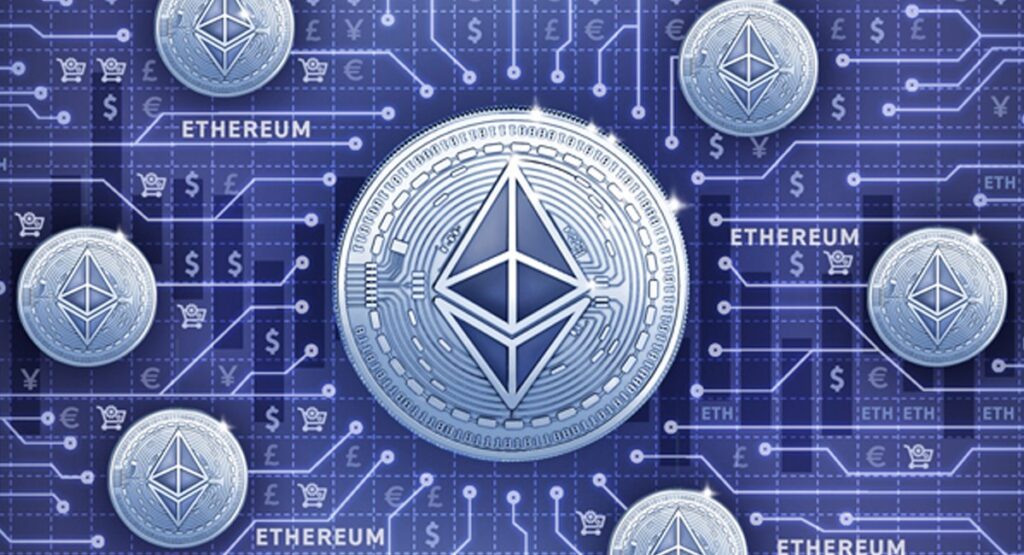Launched in 2015, Ethereum is a decentralized blockchain network powered by its native crypto, ETH. Vitalik Buterin, along with a team of co-founders, developed Ethereum after realizing the potential of blockchain networks to go beyond digital transactions.
The Ethereum network has expanded on Bitcoin’s vision of being a decentralized payment system by building a marketplace of decentralized applications, or dApps. These dApps offer crypto users unmatched security, control, and efficiency. The Ethereum network uses innovative features like smart contracts to develop dApps in multiple fields such as finance, gaming, advertising, and supply chain.
The Ethereum network enables developers to create new types of ETH based tokens that power new dApps. Most ETH-based crypto tokens are built using the ERC-20 standard. Smart contracts are a vital innovation on the Ethereum blockchain. These are self-executing programs that facilitate and verify transactions on the Ethereum blockchain. Thousands of dApps have already been built on the Ethereum network, resulting in millions of users and revenues. This article will explore the top 5 Ethereum use cases.
Read more: What is Ethereum
Decentralized finance (DeFi)
The most promising Ethereum use cases are decentralized finance applications, often referred to as DeFi applications. These use cases include minting stablecoins, smart contract-enabled loans, and decentralized crypto exchanges. MakerDAO is one of the most significant projects under DeFi. This project uses smart contracts to create a stablecoin known as DAI. DAI is backed by Ether and is always pegged close to $1.
Smart contracts can revolutionize the financial world by simplifying several processes and speeding up transactions. The transparency of transactions can be maintained as all the terms are visible to all parties involved in a smart contract. The Ethereum network is already being used to simplify international payments, mortgages, and insurance claims; organize online databases; and make transactions transparent and fast. Ethereum smart contracts can also be used to automatically transfer money when a bond is about to mature without involving a third party, making the process faster and more transparent.
Digital art and collectibles
NFTs were first minted on the Ethereum network in 2017 and have become popular over the last few years. NFTs have the potential to revolutionize the art world, as they can help with proof-of-ownership and provide provenance. NFT marketplaces are also available on alternative blockchains, but some of the largest exist on the Ethereum network. Bored Ape Yacht Club and CryptoKitties are some of the prominent NFT collections. Many traditional auction houses like Christie’s have made several NFT sales.
Gaming
The gaming industry is quickly realizing the potential of blockchain technology. Ethereum’s NFTs, through their unique proof-of-ownership feature, have enabled in-game items and rewards to become assets. Popular Ethereum-based games like Sandbox and Axie Infinity have helped in the advancement of NFTs and play-to-earn games. Gamers can earn crypto assets that can be sold or traded in these play-to-earn games. In-game concerts, NFT drops, and virtual land sales continue to propel the play-to-earn space.
ICOs or DAICOs
Crypto token sales, or ICOs, can be more effective by implementing Ethereum’s smart contract. It makes the crypto token sales process more transparent. DAICO is a combination of the ICO and DAO models. The DAICO model has introduced a new feature called tap. The older ICO model begins with contribution mode, where investors would contribute ETH in compliance with ICO rules. In the DAICO model, the tap feature determines the amount of ETH a developer can withdraw per second, and this withdrawal limit is decided by DAICO contributors. The tap feature keeps a check on the developers by restricting the withdrawal limit and giving limited access to the entire contributed amount. The tap feature in the DAICO model shows how smart contracts can be used efficiently to manage ICOs.
Digital identity
Little has changed in the way we identify ourselves over the last few decades. We still need to carry passports everywhere to identify ourselves. The authenticity of an offline document is the main reason why governments have not entirely to digital systems.
Ethereum can solve this issue and can be a pioneer of digital identification systems. Companies can verify data openly and transparently using the Ethereum blockchain. Some companies are already working on making new systems using the Ethereum network. Ethereum-enabled identity systems can solve issues like data monopolies and identity theft.
Conclusion
The Ethereum blockchain plays a vital role in the rise of blockchain technology. Ethereum dApps have the potential to revolutionize industries such as finance, gaming, and supply chain management. The Ethereum ecosystem will continue to grow as more projects and users emerge.
Ethereum is the blockchain of choice for innovation in the crypto space. Using its robustness and flexibility, new dApps continue to emerge. Increased scalability will support the development of the Ethereum ecosystem. From DeFi applications to GameFi, the future of Ethereum looks exciting.
You can now Buy Ethereum on ZebPay India.
Disclaimer: Crypto products and NFTs are unregulated and can be highly risky. There may be no regulatory recourse for any loss from such transactions. Each investor must do his/her own research or seek independent advice if necessary before initiating any transactions in crypto products and NFTs. The views, thoughts, and opinions expressed in the article belong solely to the author, and not to ZebPay or the author’s employer or other groups or individuals. ZebPay shall not be held liable for any acts or omissions, or losses incurred by the investors. ZebPay has not received any compensation in cash or kind for the above article and the article is provided “as is”, with no guarantee of completeness, accuracy, timeliness or of the results obtained from the use of this information.
